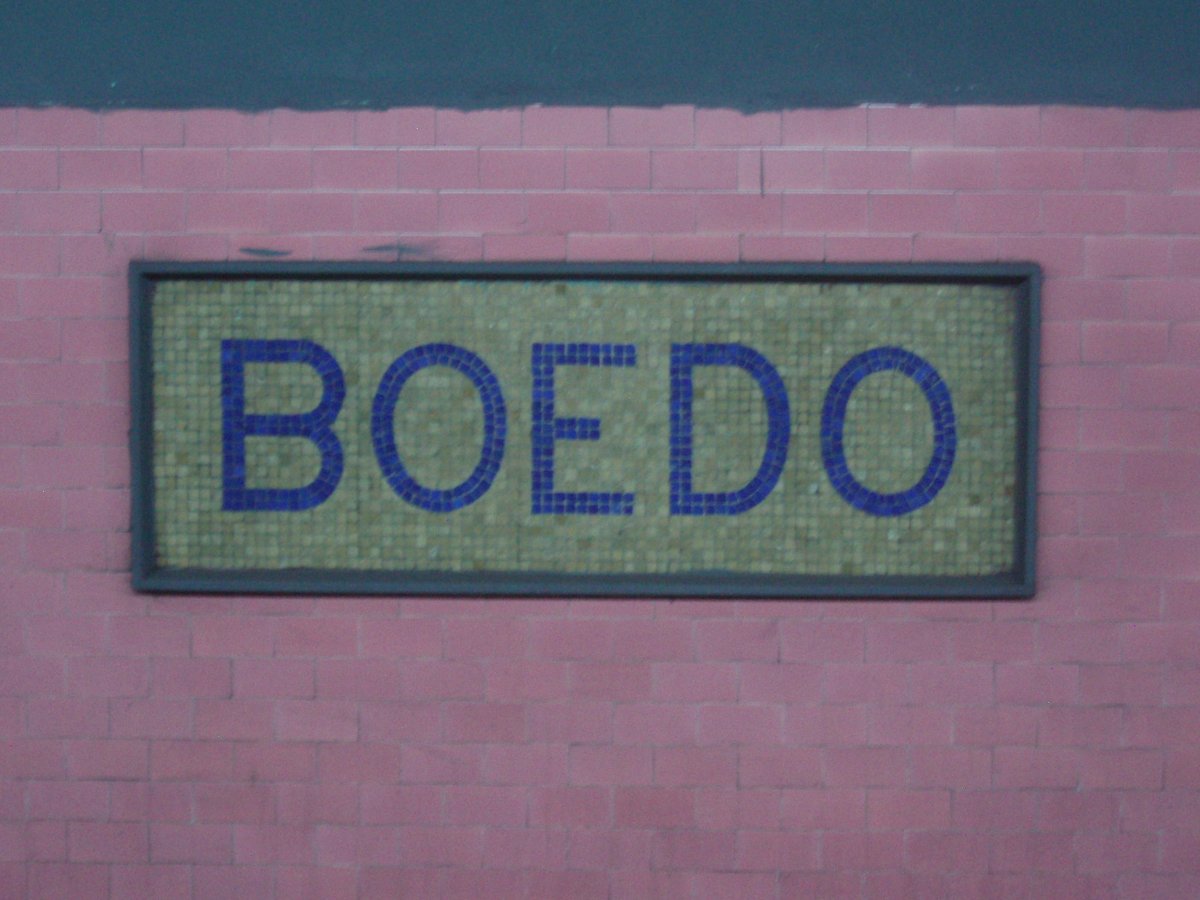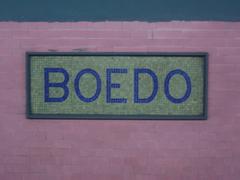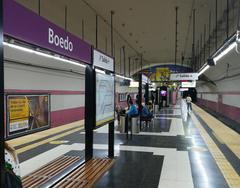Boedo Buenos Aires: Visiting Hours, Tickets, and Historical Sites Guide
Date: 15/06/2025
Introduction
Nestled in the heart of Buenos Aires, Boedo stands out as a neighborhood rich in cultural heritage, social activism, and artistic expression. Revered for its deep ties to tango, literature, and gastronomy, Boedo offers a unique and immersive experience for visitors seeking to explore authentic porteño life. From historic cafés and legendary tango venues to vibrant murals and literary circuits, Boedo is a living tapestry of Buenos Aires’ past and present (Wikipedia, TodoTango, Gringo in Buenos Aires).
This detailed guide provides essential visitor information, including visiting hours, ticketing, accessibility, tips for getting around, and recommendations for must-see sites. Whether you are a history buff, tango enthusiast, foodie, or art lover, Boedo invites you to discover Buenos Aires beyond the traditional tourist path.
Table of Contents
- Introduction
- Tango: The Heartbeat of Boedo
- Literary Heritage: The Boedo Group and Beyond
- Artistic Expression: Murals, Sculptures, and Creative Spaces
- Social and Political Roots
- Living Traditions: Festivals, Nightlife, and Everyday Life
- Visitor Information: How to Experience Boedo
- Cultural Landmarks and Points of Interest
- Historic and Cultural Landmarks
- Artistic and Literary Attractions
- Parks and Public Spaces
- Gastronomic Highlights
- Tango and Nightlife
- Shopping and Artisan Markets
- Religious and Architectural Sites
- Annual Events and Festivals
- Travel Tips
- FAQ
- Boedo Dining Guide
- Summary and Final Recommendations
- References
Tango: The Heartbeat of Boedo
Boedo is synonymous with tango, both as a musical genre and cultural institution. The neighborhood’s streets, especially Avenida Boedo and the iconic intersection at San Juan and Boedo, have been immortalized in tango lyrics. Classic compositions such as Julio De Caro’s “Boedo” and Homero Manzi’s “Sur” celebrate the area’s working-class roots and vibrant spirit (Wikipedia, TodoTango).
Key venues like Esquina Homero Manzi host nightly tango performances and festivals, while cafés and bars offer live music and milongas for dancers of all levels (Gringo in Buenos Aires, CABA City).
Literary Heritage: The Boedo Group and Beyond
In the 1920s, the Boedo Group—a collective of socially conscious writers—used literature as a tool for activism and commentary. Figures such as Enrique Amorim and Nicolás Olivari published influential works reflecting the neighborhood’s working-class struggles (Wikipedia, Buenos Aires Historia). The literary circuit along Avenida Boedo features plaques and murals commemorating these writers.
Artistic Expression: Murals, Sculptures, and Creative Spaces
Boedo’s streets double as open-air galleries, adorned with murals and sculptures that celebrate its history and contemporary creativity. The Paseo de las Esculturas, located along Avenida Boedo, features works by local artists (CABA City). Traditional cafés like Confitería Trianón remain gathering spots for artists and intellectuals.
Social and Political Roots
A hub for immigrants, workers, and political activism, Boedo’s growth in the late 19th and early 20th centuries was fueled by families with anarchist and socialist ideals (CABA City). The neighborhood’s architecture—marked by terraced houses and social clubs—reflects its community-oriented ethos.
Living Traditions: Festivals, Nightlife, and Everyday Life
Boedo hosts a lively calendar of tango festivals, literary events, and community markets. The nightlife is authentic and welcoming, featuring historic cafés, parrillas, and pizzerias, as well as European-style pubs like Cossab for craft beer. Many venues also function as cultural centers, hosting art exhibitions, readings, and workshops (Gringo in Buenos Aires).
Visitor Information: How to Experience Boedo
- Visiting Hours: Cultural venues generally open from late afternoon to midnight; historic cafés and museums typically operate 10:00 AM–8:00 PM. Confirm hours, as they may vary by season.
- Tickets and Entry: Many tango shows and festivals require tickets—purchase online or at the venue. Street art and public spaces are free to explore.
- Accessibility: The neighborhood’s flat layout and transit options make it accessible, though some older buildings may have limited wheelchair access.
- Getting There: Reach Boedo via Subte Line E (Boedo station) or by bus; taxi and rideshare are also convenient from downtown.
- Nearby Attractions: Explore neighboring areas such as San Cristóbal and Almagro for additional cultural and dining options.
Cultural Landmarks and Points of Interest
Historic and Cultural Landmarks
- Esquina Homero Manzi: Historic tango café and performance venue (Wikipedia, Esquina Homero Manzi)
- Café Margot: Iconic café with a literary legacy (Café Margot)
- Confitería Trianón: Artistic and intellectual meeting spot (CABA City)
- San Lorenzo de Almagro Stadium: Home of the renowned football club; guided tours available (San Lorenzo official site)
Artistic and Literary Attractions
- Boedo Literary Circuit: Self-guided tour of literary plaques and murals (Buenos Aires Ciudad: Circuitos Literarios)
- Murals and Urban Art: Explore vibrant street art (BA Street Art)
- Teatro Boedo XXI: Independent theater for contemporary performances (Teatro Boedo XXI)
Parks and Public Spaces
- Plaza Mariano Boedo: Central plaza with playgrounds and a monument (Buenos Aires Ciudad: Plazas)
- Parque Chacabuco: Expansive park with sports and recreation (Parque Chacabuco)
Gastronomic Highlights
Boedo’s culinary scene reflects its multicultural roots, offering everything from classic porteño dishes to innovative contemporary cuisine.
- Traditional Parrillas: Try El Puentecito for asado and chimichurri (Parrilla El Puentecito)
- Pizzerias: Sample Buenos Aires-style pizza at San Antonio or Tuñín (Pizzería San Antonio)
- Cafés and Bars: Café Margot and Pan y Arte are must-visits (buenosairesfreewalks.com)
Tango and Nightlife
- Milongas and Tango Bars: Club Grisel and La Catedral Club offer lessons, live music, and social dancing (Club Grisel)
- Live Music Venues: Bar de Cao and Espacio Cultural Julián Centeya present diverse performances (Espacio Cultural Julián Centeya)
Shopping and Artisan Markets
- Feria de Boedo: Open-air weekend market for crafts, books, and regional foods (Feria de Boedo)
- Independent Bookstores: El Gato Escaldado and Librería Santa Fe curate local literature (Librería El Gato Escaldado)
Religious and Architectural Sites
- Parroquia San Bartolomé Apóstol: Neo-Gothic church and cultural event host (Parroquia San Bartolomé Apóstol)
- Historic Residences: Walking tours highlight early 20th-century homes and Boedo’s immigrant heritage (Buenos Aires Ciudad: Arquitectura)
Annual Events and Festivals
- Festival de Tango de Boedo: Annual celebration with concerts, dances, and workshops (Festival de Tango de Boedo)
- Carnaval Porteño: February parades and dances fill the streets (Carnaval Porteño)
Travel Tips
- Best Time to Visit: Spring (September–November) and fall (March–May) offer pleasant weather and fewer crowds.
- Getting There: Subte Line E (Boedo station) and numerous bus lines provide easy access.
- Photographic Spots: Don’t miss Esquina Homero Manzi’s façade and the murals along Avenida Boedo.
- Guided Tours: Available for many attractions and highly recommended for cultural context.
FAQ
Q: Are tickets needed for public spaces and landmarks?
A: Most public sites are free, but tango shows and theatrical performances require tickets.
Q: Is Boedo accessible for visitors with mobility challenges?
A: Many venues are wheelchair accessible; check with individual sites for accommodations.
Q: Can beginners attend tango events?
A: Absolutely—many milongas welcome newcomers and offer dance lessons.
Q: Is English spoken in local eateries?
A: English is not widely spoken; basic Spanish or a translation app is helpful (thethoroughtripper.com).
Boedo Dining Guide
Traditional Flavors and Culinary Heritage
Boedo’s food culture is shaped by Italian and Spanish immigration, creole influences, and its working-class history (turismo.buenosaires.gob.ar). Meals are hearty, accessible, and communal.
Classic Porteño Cafés and Notable Bars
- Café Margot: Known for its turkey sandwiches, picadas, and historic ambiance (Café Margot, buenosairesfreewalks.com).
- Pan y Arte: Blends traditional Argentine cuisine with creative flair.
Signature Dishes and Local Specialties
- Empanadas: Savory pastries with various fillings (thethoroughtripper.com).
- Milanesa: Breaded cutlet, often served “a la napolitana.”
- Picadas: Cured meats, cheeses, olives, and breads for sharing.
- Pizza and Pasta: Italian-style offerings, including thick-crust pizza and homemade pastas, especially gnocchi on the 29th (turismo.buenosaires.gob.ar).
- Asado: Local parrillas serve grilled meats with chimichurri sauce.
Contemporary Dining and Innovation
A new wave of chefs is modernizing traditional cuisine with global influences (worldofmouth.app).
Sweets and Desserts
- Dulce de leche treats, medialunas, facturas, and cakes are staples of local bakeries.
Street Food and Casual Eats
- Choripán: Grilled chorizo sandwich, a popular snack at festivals.
- Fugazzeta: Cheese-stuffed onion pizza (thethoroughtripper.com).
Dining Hours and Customs
Lunch is typically 12:30–3:00 PM; dinner starts after 8:00 PM. A relaxed, social atmosphere is the norm. Reservations are rarely required but advised for groups or events (turismo.buenosaires.gob.ar).
Wine, Beer, and Beverages
Local wines (especially Malbec) and craft beers are widely available. Try mate or submarino in cafés (thethoroughtripper.com).
Visitor Tips
- Carry cash; credit cards are accepted at most sit-down restaurants, but check ahead.
- Tipping: 10% is customary.
- Vegetarian and vegan options are increasingly available.
Noteworthy Establishments
- Café Margot: Bar and picadas (buenosairesfreewalks.com)
- El Banderín: Celebrated for its football memorabilia
Food Festivals and Community Events
Boedo participates in citywide events like Masticar and Buenos Aires Food Week (turismo.buenosaires.gob.ar, buenosaires.com).
Summary and Final Recommendations
Boedo is a neighborhood where Buenos Aires’ cultural, historical, and culinary traditions come alive. From its foundational role in tango and literature to its vibrant murals and legendary cafés, Boedo offers an authentic, multifaceted experience (CABA City, Buenos Aires Historia). Its welcoming atmosphere, accessible public spaces, and rich calendar of events make it a must-visit for travelers seeking a deeper connection with the city (buenosairesfreewalks.com, turismo.buenosaires.gob.ar).
For up-to-date information, guided tours, and insider tips, explore official platforms and local resources. Embrace Boedo’s living culture, let its rhythms and flavors inspire your journey, and use the Audiala app for additional recommendations (Esquina Homero Manzi, Festival de Tango de Boedo).
References
- Wikipedia - Boedo
- TodoTango - Story of the tango Boedo
- Gringo in Buenos Aires - Neighborhood Guide
- CABA City - Boedo Barrios
- Buenos Aires Historia - Juntas de Poetas
- Café Margot Official Site
- Esquina Homero Manzi Official Site
- San Lorenzo Official Site
- Buenos Aires Ciudad: Circuitos Literarios
- BA Street Art
- Teatro Boedo XXI
- Buenos Aires Ciudad: Plazas
- Parque Chacabuco
- Parrilla El Puentecito - TripAdvisor
- Pizzería San Antonio - TripAdvisor
- Club Grisel Facebook
- Espacio Cultural Julián Centeya
- Feria de Boedo
- Librería El Gato Escaldado Facebook
- Parroquia San Bartolomé Apóstol Facebook
- Buenos Aires Ciudad: Arquitectura
- Festival de Tango de Boedo
- Carnaval Porteño
- Turismo Buenos Aires: What, Where and When to Eat
- Buenos Aires Free Walks: Boedo Guide
- The Thorough Tripper: Buenos Aires Travel Tips
- World of Mouth: Best Restaurants in Buenos Aires
- Buenos Aires Festivals
































































































































































